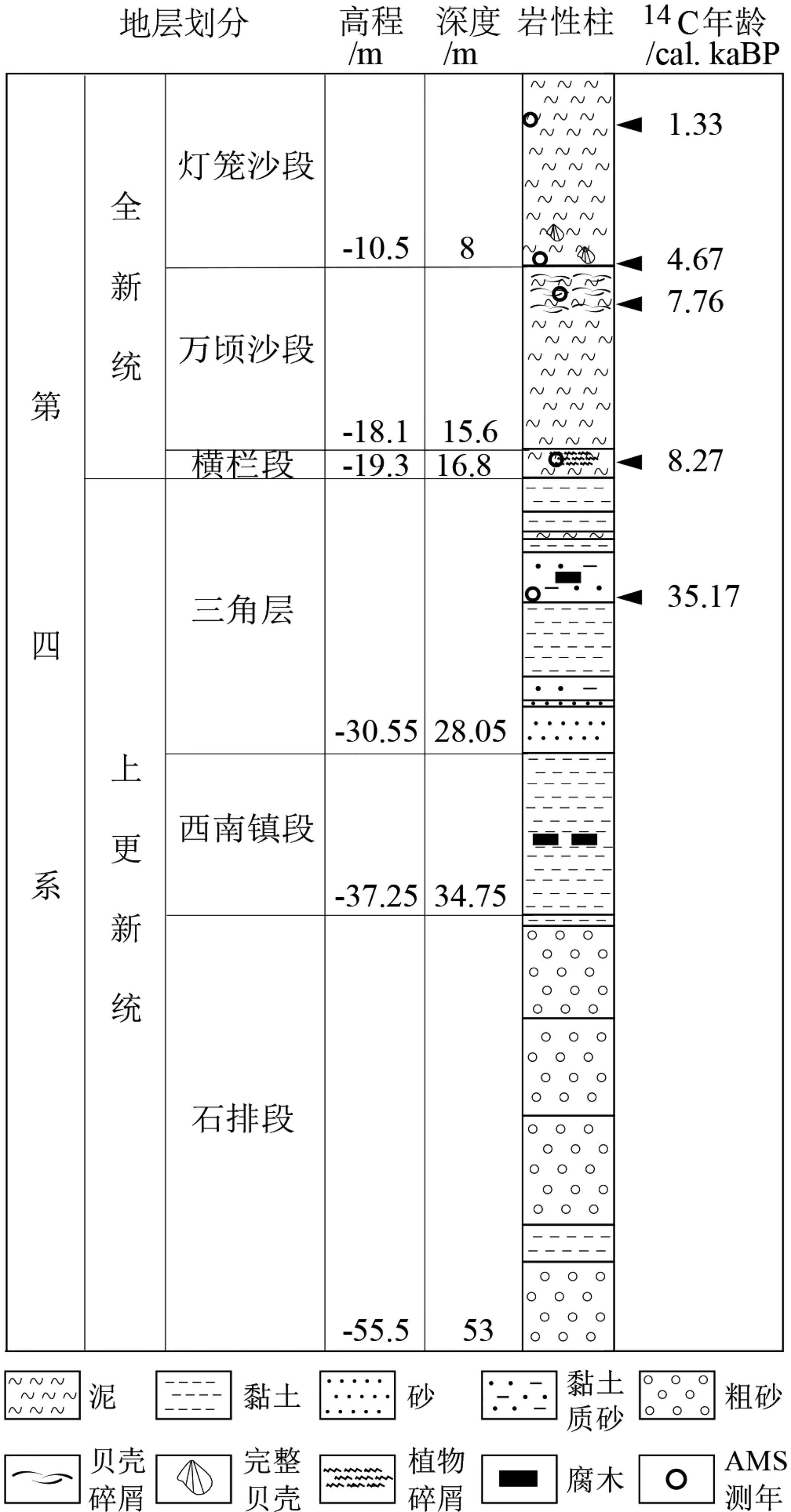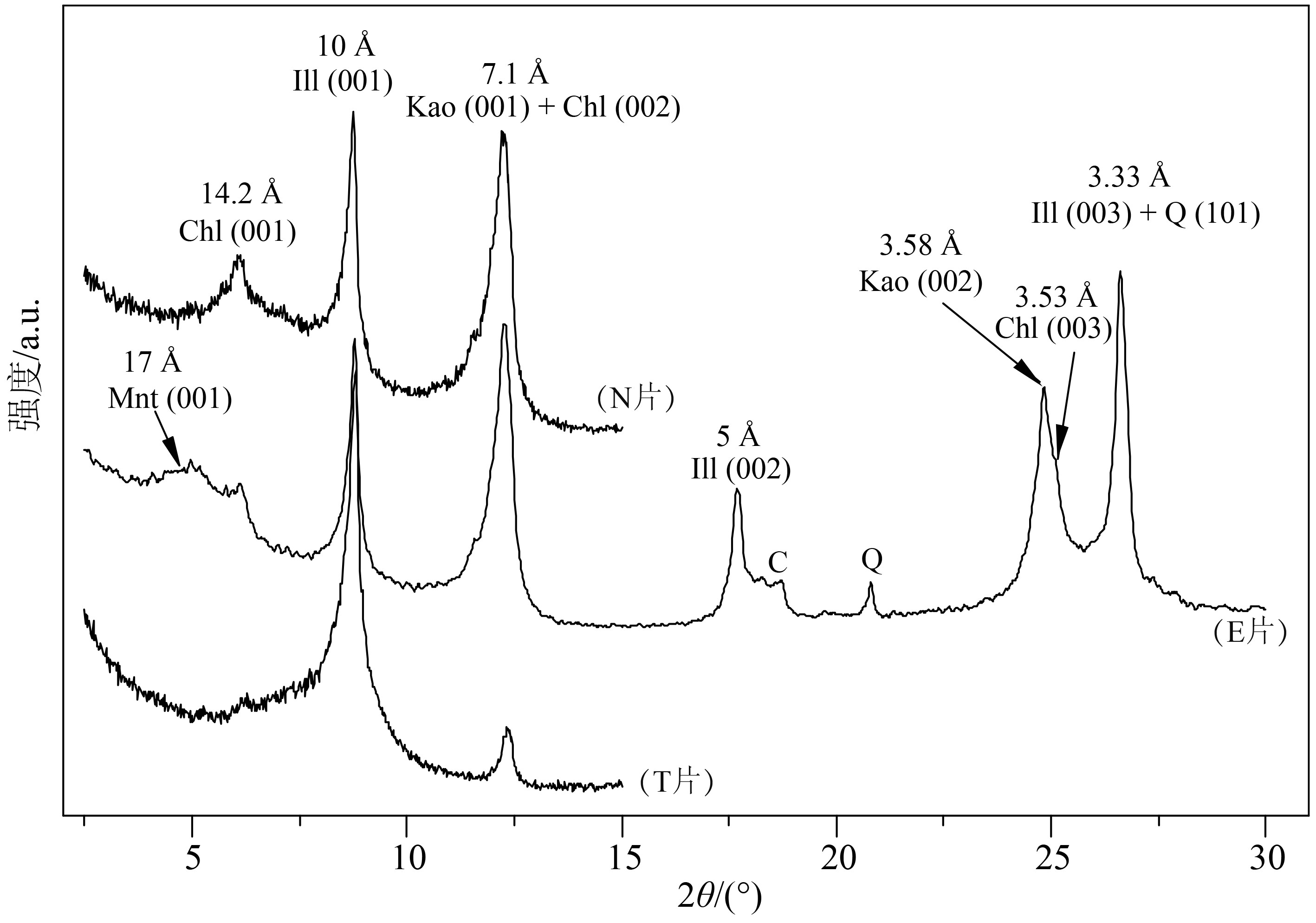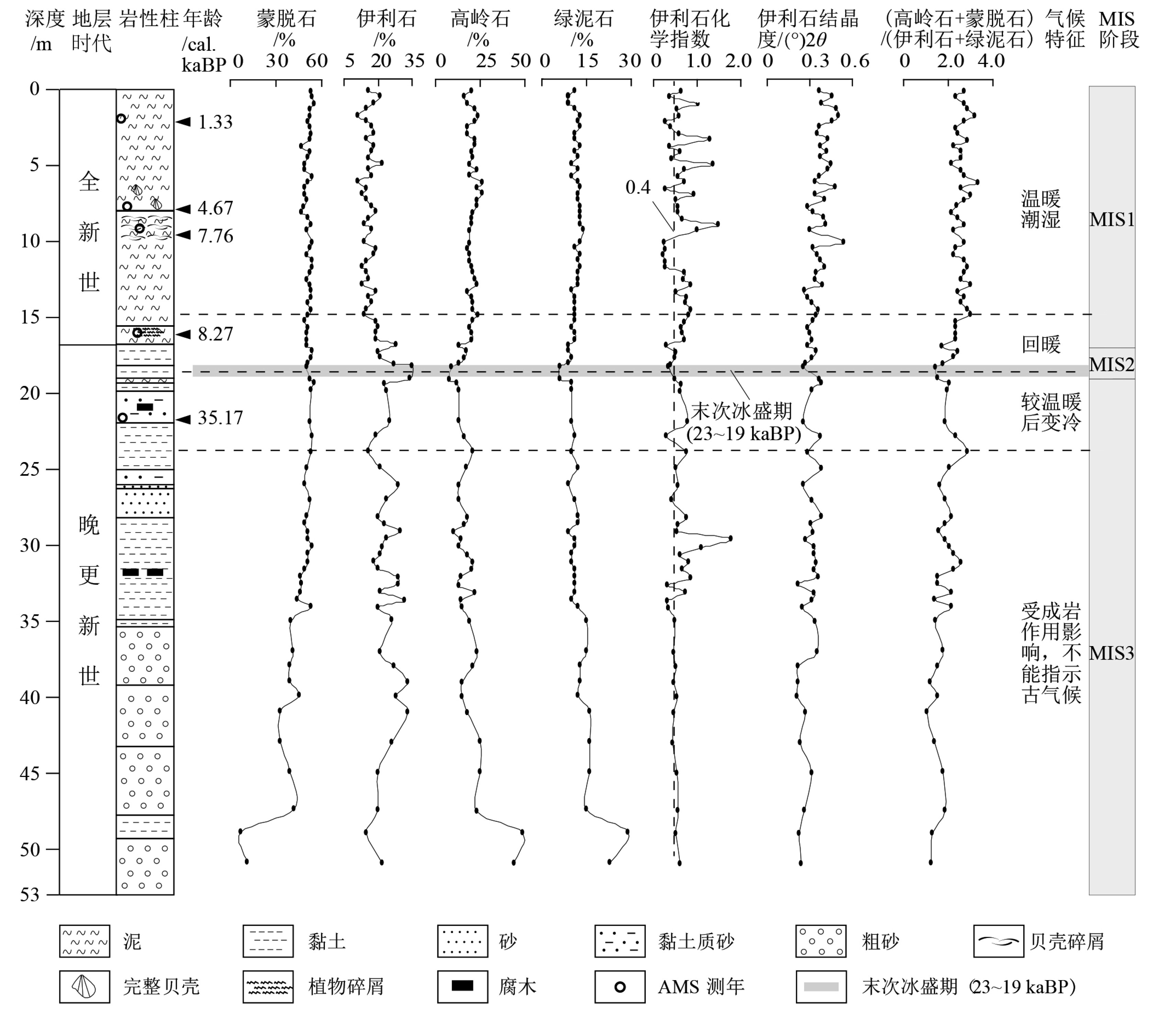Late Quaternary clay minerals in the inner Lingdingyang of the Pearl River Estuary, southern China: Implications for paleoclimate changes at the provenance
-
摘要:
黏土矿物组合和相对含量变化可反映源区地表风化过程,进而推断古气候的周期性变化,因此黏土矿物分析是古气候重建的重要手段之一。对珠江口内伶仃洋13-LD-ZK20钻孔晚第四纪沉积物中黏土矿物组成进行分析,结果显示黏土矿物主要为蒙脱石(含伊利石/蒙脱石无序混层),平均相对含量为49%,其次为伊利石、高岭石和绿泥石,平均相对含量分别为20%、19%和12%。伊利石化学指数较高(多数大于0.4),指示源区强烈的化学风化作用。珠江口内伶仃洋晚第四纪以来黏土矿物根据其相对含量变化和岩芯是否受成岩作用影响可分为4个阶段,指示西江源区气候总体暖-冷-暖的变化趋势。晚更新世第1阶段黏土矿物受成岩作用影响,不具古气候指示意义,第2阶段初期较为温暖,末期存在短期气候相对干冷阶段,可能与晚更新世末次冰盛期有关,第3阶段前期稍转暖。全新世(第3阶段后期和第4阶段)主要为温暖潮湿气候特征,并存在短期冷-暖波动。
Abstract:Clay minerals are good indicators of paleoclimate changes , and therefore, clay mineral analysis is commonly used as a powerful tool for paleoclimate reconstruction. In this study, the assemblages and relative contents of clay minerals of the Late Quaternary sediments from the drill core 13-LD-ZK20 in the inner Lingdingyang of the Pearl River Estuary are analyzed. Our results suggest that the clay mineral assemblages are dominated by smectite on an average content of about 49% including illite-smectite mixed-layers clay mineral(R=0), followed by illite, kaolinite and chlorite on average of 20%, 19% and 12%, respectively. The high illite chemical weathering index is mostly greater than 0.4, which signify intense chemical weathering at the provenance. The Late Quaternary deposits of the region can be subdivided into four stages based on the composition of clay minerals and the diagenesis of sediments. It indicates a fluctuated paleoclimate pattern in the Xijiang drainage from warm, cold to warm again. Paleoclimate was unable to be reconstructed with clay minerals for the first stage of Late Pleistocene, due to strong diagenesis. In the second stage, it was warm in the beginning and turned cold by the end of the stage, most likely related to the Last Glacial Maximum. Then the paleoclimate slightly turned warmer in the early third stage. The paleoclimate in the Holocene was warm and humid with short periods of fluctuations.
-

-
[1] Zhang Q, Xiao M Z, Singh V P, et al. Regionalization and spatial changing properties of droughts across the Pearl River basin, China [J]. Journal of Hydrology, 2012, 472-473: 355-366. doi: 10.1016/j.jhydrol.2012.09.054
[2] Liu Y T, Song C H, Meng Q Q, et al. Paleoclimate change since the Miocene inferred from clay-mineral records of the Jiuquan Basin, NW China [J]. Palaeogeography, Palaeoclimatology, Palaeoecology, 2020, 550: 109730. doi: 10.1016/j.palaeo.2020.109730
[3] Chamley H. Clay Sedimentology[M]. Berlin: Springer-Verlag, 1989: 1-621.
[4] Dera G, Pellenard P, Neige P, et al. Distribution of clay minerals in Early Jurassic Peritethyan seas: Palaeoclimatic significance inferred from multiproxy comparisons [J]. Palaeogeography, Palaeoclimatology, Palaeoecology, 2009, 271(1-2): 39-51. doi: 10.1016/j.palaeo.2008.09.010
[5] Kemp S J, Ellis M A, Mounteney I, et al. Palaeoclimatic implications of high-resolution clay mineral assemblages preceding and across the onset of the Palaeocene–Eocene Thermal Maximum, North Sea Basin [J]. Clay Minerals, 2016, 51(5): 793-813. doi: 10.1180/claymin.2016.051.5.08
[6] Song Y G, Wang Q S, An Z S, et al. Mid-Miocene climatic optimum: Clay mineral evidence from the red clay succession, Longzhong Basin, Northern China [J]. Palaeogeography, Palaeoclimatology, Palaeoecology, 2017, 512: 46-55. doi: 10.1016/j.palaeo.2017.10.001
[7] Wang Q S, Song Y G, Li Y, et al. The climate changes from clay minerals recorded by the Zhuanglang red clay on the western Chinese loess Plateau [J]. Acta Geologica Sinica (English Edition), 2018, 92(S2): 109-112.
[8] Liu Z F, Colin C, Huang W, et al. Clay minerals in surface sediments of the Pearl River drainage basin and their contribution to the South China Sea [J]. Chinese Science Bulletin, 2007, 52(8): 1101-1111. doi: 10.1007/s11434-007-0161-9
[9] 时翠, 甘华阳, 马胜中, 等. 晚更新世以来内伶仃洋河口湾的地层层序和沉积演化[J]. 海洋地质前沿, 2015, 31(10):8-18
SHI Cui, GAN Huayang, MA Shengzhong, et al. Late Quaternary evolution and sequence stratigraphy of the Lingdingyang Eatuary in south China [J]. Marine Geology Frontiers, 2015, 31(10): 8-18.
[10] 马胜中, 倪玉根, 林进清, 等. 1: 5万珠江口内伶仃洋海洋区域地质调查(试点)2013年度成果报告[R]. 广州: 广州海洋地质调查局, 中国, 2013: 1-128.
MA Shengzhong, NI Yugen, LIN Jinqing, et al. Annual report of marine regional geological survey (pilot project) of inner Lingdingyang in the Pearl River Estuary (1: 50000) in 2013[R]. Guangzhou: Guangzhou Marine Geological Survey, China, 2013: 1-128.
[11] Brown T A, Nelson D E, Mathewes R W, et al. Radiocarbon dating of pollen by accelerator mass spectrometry [J]. Quaternary Research, 1989, 32(2): 205-212. doi: 10.1016/0033-5894(89)90076-8
[12] Holtzapffel T. Les minéraux argileux: préparation, analyse diffractométrique et determination [J]. Société Géologique du Nord, 1985, 12: 1-136.
[13] Soleimani B. Paleoclimate reconstruction during Pabdeh, Gurpi, Kazhdumi and Gadvan formations (Cretaceous-Tertiary) based on clay mineral [J]. International Journal of Civil and Environmental Engineering, 2009, 1(2): 59-63.
[14] Chaudhri A R, Singh M. Clay minerals as climate change indicators-a case study [J]. American Journal of Climate Change, 2012, 1(4): 231-239. doi: 10.4236/ajcc.2012.14020
[15] Fagel N, Boski T, Likhoshway L, et al. Late Quaternary clay mineral record in Central Lake Baikal (Academician Ridge, Siberia) [J]. Palaeogeography, Palaeoclimatology, Palaeoecology, 2003, 193(1): 159-179. doi: 10.1016/S0031-0182(02)00633-8
[16] Lamy F, Hebbeln D, Wefer G. High-resolution marine record of climatic change in mid-latitude Chile during the Last 28, 000 years based on Terrigenous sediment Parameters [J]. Quaternary Research, 1999, 51(1): 83-93. doi: 10.1006/qres.1998.2010
[17] Esquevin J. Influence de la composition chimique des illites surcristallinite [J]. Bulletin du Centre de Recherches Rau-SNPA, 1969, 3(1): 147-153.
[18] Biscaye P E. Mineralogy and sedimentation of recent deep-sea clay in the atlantic ocean and adjacent seas and oceans [J]. GSA Bulletin, 1965, 76(7): 803-832. doi: 10.1130/0016-7606(1965)76[803:MASORD]2.0.CO;2
[19] Robert C, Kennett J P. Antarctic subtropical humid episode at the Paleocene-Eocene boundary: Clay-mineral evidence [J]. Geology, 1994, 22(3): 211-214. doi: 10.1130/0091-7613(1994)022<0211:ASHEAT>2.3.CO;2
[20] Hong H L, Li Z H, Xue H J, et al. Oligocene clay mineralogy of the Linxia Basin: Evidence of Palaeoclimatic evolution subsequent to the initial-stage uplift of the Xizang Plateau [J]. Clays and Clay Minerals, 2007, 55(5): 491-503. doi: 10.1346/CCMN.2007.0550504
[21] Wang C W, Hong H L, Song B W, et al. The early-Eocene climate optimum (EECO) event in the Qaidam basin, northwest China: clay evidence [J]. Clay Minerals, 2011, 46(4): 649-661. doi: 10.1180/claymin.2011.046.4.649
[22] Rateev M A, Gorbunova Z N, Lisitzyn A P, et al. The distribution of clay minerals in the oceans [J]. Sedimentology, 1969, 13(1-2): 21-43. doi: 10.1111/j.1365-3091.1969.tb01119.x
[23] Thiry M. Palaeoclimatic interpretation of clay minerals in marine deposits: an outlook from the continental origin [J]. Earth-Science Reviews, 2000, 49(1-4): 201-221. doi: 10.1016/S0012-8252(99)00054-9
[24] Shen X Y, Wan S M, France-Lanord C, et al. History of Asian Eolian input to the Sea of Japan since 15 Ma: Links to Xizang uplift or global cooling? [J]. Earth and Planetary Science Letters, 2017, 474: 296-308. doi: 10.1016/j.jpgl.2017.06.053
[25] 吴文中, 赵焕庭. 从沉积物的矿物分析论珠江河口湾伶仃洋的泥沙来源[J]. 热带海洋, 1982, 1(2):3-16
WU Wenzhong, ZHAO Huanting. On silt sources of Lingdingyang of the Zhujiang (Pearl River) Estuary by means of mineralogical analyses of the sediments [J]. Tropic Oceanology, 1982, 1(2): 3-16.
[26] Singer A. The paleoclimatic interpretation of clay minerals in soils and weathering profiles [J]. Earth-Science Reviews, 1980, 15(4): 303-326. doi: 10.1016/0012-8252(80)90113-0
[27] Velde B B, Meunier A. The Origin of Clay Minerals in Soils and Weathered Rocks[M]. Berlin: Springer, 2008: 1-403.
[28] Shi Y F, Yu G, Liu X D, et al. Reconstruction of the 30-40 ka BP enhanced Indian monsoon climate based on geological records from the Xizang Plateau [J]. Palaeogeography, Palaeoclimatology, Palaeoecology, 2001, 169(1-2): 69-83. doi: 10.1016/S0031-0182(01)00216-4
[29] Yang B, Shi Y F, Braeuning A, et al. Evidence for a warm-humid climate in arid northwestern China during 40-30 ka BP [J]. Quaternary Science Reviews, 2004, 23(23-24): 2537-2548. doi: 10.1016/j.quascirev.2004.06.010
[30] 刘志飞, 李夏晶, COLIN C, 等. 南海北部末次冰盛期以来高分辨率黏土矿物记录及其时间序列物源区分析[J]. 科学通报, 2010, 55(35):4058-4068 doi: 10.1007/s11434-010-4149-5
LIU Zhifei, LI Xiajing, COLIN C, et al. A high-resolution clay mineralogical record in the northern South China Sea since the Last Glacial Maximum, and its time series provenance analysis [J]. Chinese Science Bulletin, 2010, 55(35): 4058-4068. doi: 10.1007/s11434-010-4149-5
[31] 王晓静, 王建华, 曹玲珑, 等. 广州地区晚第四纪孢粉气候研究[J]. 中山大学学报: 自然科学版, 2010, 49(3):113-121
WANG Xiaojing, WANG Jianhua, CAO Linglong, et al. Late Quaternary pollen records and climate significance in Guangzhou [J]. Acta Scientiarum Naturalium Universitatis Sunyatseni, 2010, 49(3): 113-121.
[32] 郑卓, 王建华. 珠江三角洲北部晚第四纪孢粉植物群的古环境意义[J]. 热带海洋, 1998, 17(3):1-9
ZHENG Zhuo, WANG Jianhua. Paleoenvironmental significance of Late Quaternary pollen flora in northern Zhujiang river delta [J]. Tropical Oceanology, 1998, 17(3): 1-9.
[33] 施雅风. 中国第四纪冰川新论[M]. 上海: 上海科学普及出版社, 2011: 1-213.
SHI Yafeng. New Understanding of Quaternary Glaciations in China[M]. Shanghai: Shanghai Popular Science Press, 2011: 1-213.
[34] Cui Z J, Yang J F, Liu G N, et al. Discovery of Quaternary glacial evidence of Snow Mountain in Taiwan, China [J]. Chinese Science Bulletin, 2000, 45(6): 566-571. doi: 10.1007/BF02887108
[35] 杨作升. 黄河、长江、珠江沉积物中粘土的矿物组合、化学特征及其与物源区气候环境的关系[J]. 海洋与湖沼, 1988, 19(4):336-346
YANG Zuosheng. Mineralogical assemblages and chemical characteristics of clays from sediments of the Huanghe, Changjiang, Zhujiang rivers and their relationship to the climate environment in their sediment source areas [J]. Oceanologia et Limnologia Sinica, 1988, 19(4): 336-346.
[36] Huang Z G, Zhang W Q. The cooling fluctuation events during Holocene in the tropical zone of China [J]. Journal of Geographical Sciences, 2000, 12(1): 91-98.
[37] Wang N L, Yao T D, Thompson L G, et al. Evidence for cold events in the early Holocene from the Guliya ice core, Xizang Plateau, China [J]. Chinese Science Bulletin, 2002, 47(17): 1422-1427. doi: 10.1360/02tb9313
[38] 黄镇国, 张伟强. 历史时期中国热带的气候波动与自然灾害[J]. 自然灾害学报, 2004, 13(2):58-63 doi: 10.3969/j.issn.1004-4574.2004.02.009
HUANG Zhenguo, ZHANG Weiqiang. Climate fluctuation and natural disasters during historical periods in tropics of China [J]. Journal of Natural Disasters, 2004, 13(2): 58-63. doi: 10.3969/j.issn.1004-4574.2004.02.009
[39] 张伟强, 黄镇国. 珠江三角洲晚第四纪气候波动的新认识[J]. 热带地理, 2005, 25(4):298-300, 321 doi: 10.3969/j.issn.1001-5221.2005.04.002
ZHANG Weiqiang, HUANG Zhenguo. A new approach to the climatic fluctuation during late Quaternary in the pearl river delta [J]. Tropical Geography, 2005, 25(4): 298-300, 321. doi: 10.3969/j.issn.1001-5221.2005.04.002
-




 下载:
下载:



